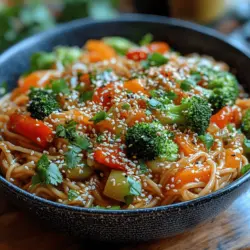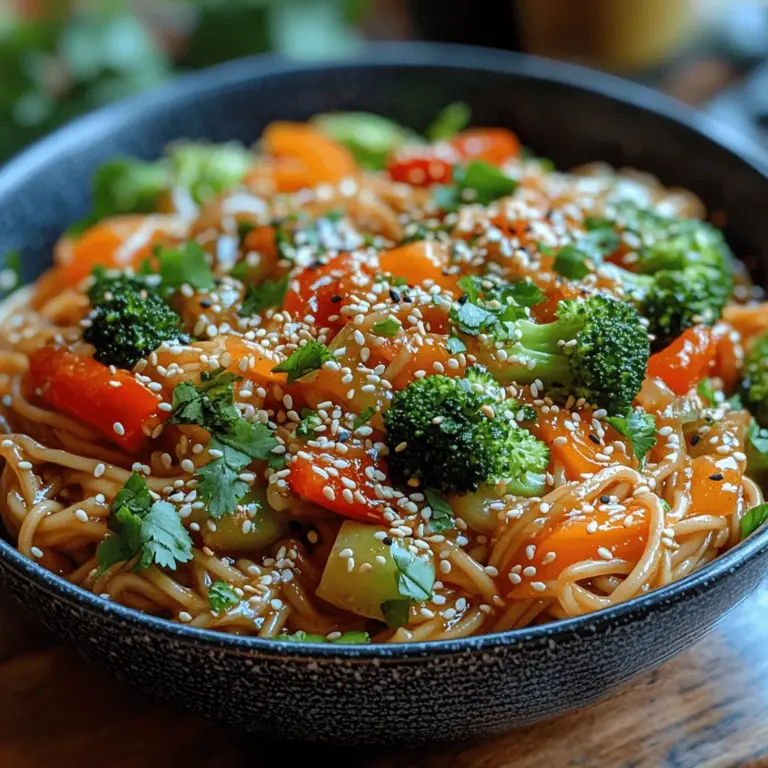Introduction
Soba noodles, a staple in Japanese cuisine, have gained popularity beyond their traditional roots, celebrated for their nutty flavor and versatility. Made primarily from buckwheat, these noodles offer a unique texture and are known for their impressive nutritional profile. Soba noodles are not only rich in protein and fiber but are also gluten-free, making them an excellent alternative for those with dietary restrictions. The remarkable health benefits of soba noodles, combined with their ability to absorb flavors, make them the perfect base for a variety of dishes.
Enter the “Fiery Soba Noodle Delight,” a vibrant stir-fried dish that elevates the humble soba noodle into a spicy and flavorful experience. This recipe marries the healthful qualities of soba with a medley of colorful vegetables and a zesty sauce that packs a punch. Whether you’re a vegetarian, vegan, or simply looking to incorporate more wholesome meals into your diet, this dish caters to a wide range of dietary preferences. The combination of heat from sriracha and the sweetness from honey or agave syrup creates a harmonious balance that will tantalize your taste buds and leave you craving more.
Understanding Soba Noodles
Description of Soba Noodles: Origin and Types
Soba noodles date back to the Edo period in Japan, where they were originally made from buckwheat flour. The name “soba” translates to “buckwheat,” which is a pseudo-cereal that is gluten-free and rich in essential nutrients. Traditionally, soba noodles are enjoyed in various ways, from hot soups to chilled salads, and they are a popular choice among health-conscious individuals.
Soba noodles come in different types, including ‘juwari’ soba, which is made of 100% buckwheat flour, and ‘hiyamugi,’ which includes a mix of buckwheat and wheat flour. The former offers a more intense nutty flavor and a firmer texture, while the latter is softer and often more accessible for those new to soba. When selecting soba noodles for our Fiery Soba Noodle Delight, opt for high-quality options that emphasize buckwheat as the primary ingredient for the best flavor and health benefits.
Nutritional Benefits of Soba Noodles Compared to Regular Pasta
When comparing soba noodles to traditional wheat pasta, soba stands out due to its superior nutritional profile. Soba noodles contain more protein and fiber than regular pasta, making them more filling and beneficial for digestive health. They are also rich in antioxidants, vitamins B1 (thiamine) and B2 (riboflavin), and minerals such as manganese and magnesium, which are crucial for energy production and overall metabolic function.
Moreover, the low glycemic index of soba noodles means they can help regulate blood sugar levels, making them a smart choice for individuals managing diabetes or those looking to maintain steady energy levels throughout the day. In summary, incorporating soba noodles into your diet not only enhances the flavor of your meals but also provides a wealth of health benefits.
Tips on Sourcing High-Quality Soba Noodles
To ensure you get the most out of your soba noodle experience, it’s essential to choose high-quality noodles. Look for brands that use 100% buckwheat flour and avoid those that contain additives or preservatives. Many Asian grocery stores carry a variety of soba noodles, but you can also find them in the international section of larger supermarkets.
When purchasing soba noodles, check the packaging for information on the ratio of buckwheat to wheat flour. As a rule of thumb, the higher the percentage of buckwheat, the better the quality. Additionally, consider trying fresh soba noodles if available, as they offer a delightful texture that dried noodles cannot replicate.
Key Ingredients in Fiery Soba Noodle Delight
To create the perfect Fiery Soba Noodle Delight, it’s essential to understand the role of each ingredient in the dish. The following overview highlights the key components and their contributions to the overall flavor and nutritional profile.
Soba Noodles: Health Benefits and Cooking Tips
As previously mentioned, soba noodles are the star of this dish. They are packed with nutrients and provide a satisfying base for our stir-fry. When cooking soba noodles, keep in mind the importance of timing. Overcooking can lead to a mushy texture, so follow the package instructions closely. Once cooked, rinse the noodles under cold water to remove excess starch, which will help prevent clumping during the stir-frying process.
Sesame Oil: Flavor Profile and Health Benefits
Sesame oil is a crucial ingredient in this recipe, as it adds a rich, nutty flavor that complements the soba noodles beautifully. This oil is not only delicious but also has numerous health benefits. It is high in polyunsaturated fats and antioxidants, which can help reduce inflammation and support heart health. When using sesame oil in cooking, it’s best to add it at the end of the cooking process to preserve its flavor and nutritional properties.
Aromatics: Onions, Garlic, and Ginger
In Asian cuisine, aromatics play a vital role in building flavor. In our Fiery Soba Noodle Delight, onions, garlic, and ginger are essential for creating a well-rounded taste profile. Onions add sweetness and depth, while garlic brings a pungent, savory note. Ginger contributes a refreshing spiciness that enhances the overall flavor of the dish. When preparing your ingredients, be sure to finely chop the garlic and ginger to release their essential oils, allowing them to infuse the dish with their robust flavors.
Vegetables: Nutritional Value and Flavor Contributions
A vibrant assortment of vegetables adds color, texture, and essential nutrients to the Fiery Soba Noodle Delight. For this recipe, we recommend using red bell pepper, broccoli, snap peas, and carrots.
– Red Bell Pepper: Packed with vitamins A and C, red bell peppers add a sweet crunch and beautiful color to the dish.
– Broccoli: This nutrient-dense vegetable is a great source of fiber, vitamins K and C, and antioxidants, making it a powerhouse in any meal.
– Snap Peas: These tender pods add a delightful crispness and natural sweetness while contributing vitamin C and fiber.
– Carrots: Rich in beta-carotene and fiber, carrots add a subtle sweetness and vibrant orange hue to the dish.
Combining these vegetables not only enhances the nutritional value of the meal but also creates a visually appealing dish that is sure to impress.
Sauces: Balancing Flavors of Heat, Sweetness, and Acidity
The sauce is where the magic happens in our Fiery Soba Noodle Delight. A well-balanced sauce will tie all the ingredients together, creating a harmonious flavor profile. For this recipe, we will use soy sauce, sriracha, rice vinegar, and honey (or agave syrup) to achieve the perfect balance of heat, sweetness, and acidity.
– Soy Sauce: A staple in Asian cooking, soy sauce adds umami flavor and saltiness, enhancing the overall taste of the dish.
– Sriracha: This chili sauce brings heat and a hint of sweetness, making it the perfect addition for those who love spicy food. Adjust the amount based on your heat tolerance.
– Rice Vinegar: Rice vinegar introduces a mild acidity that helps brighten the flavors and balance the richness of the sesame oil.
– Honey or Agave Syrup: To counteract the heat and saltiness, a touch of honey or agave syrup adds sweetness, creating a well-rounded flavor profile.
Step-by-Step Cooking Instructions
Now that we understand the key ingredients in our Fiery Soba Noodle Delight, it’s time to dive into the cooking process. Follow these detailed steps to create a delicious and satisfying meal.
Cooking the Soba Noodles: Importance of Timing and Rinsing
1. Prepare the Ingredients: Before you begin cooking, gather all your ingredients and prepare them. Chop the vegetables into bite-sized pieces, mince the garlic and ginger, and measure out the sauces. This prep work will help streamline the cooking process and ensure everything cooks evenly.
2. Cook the Soba Noodles: Bring a large pot of water to a boil. Once boiling, add the soba noodles and cook according to the package instructions, usually about 5-7 minutes. Stir gently to prevent the noodles from sticking together.
3. Rinse the Noodles: Once the noodles are cooked to al dente perfection, drain them in a colander and rinse them under cold water for about 30 seconds. This step is crucial as it removes excess starch, preventing the noodles from becoming gummy during stir-frying.
4. Set Aside: After rinsing, set the soba noodles aside while you prepare the stir-fry. This will allow you to focus on cooking the vegetables and sauce without worrying about overcooking the noodles.
As we continue into the next part of this recipe, we will explore how to combine all these elements for a flavorful and satisfying meal. Stay tuned as we delve deeper into the cooking instructions and tips for achieving the best results with your Fiery Soba Noodle Delight!
Sautéing Aromatics: Techniques for Optimal Flavor Extraction
To create the perfect base for your Fiery Soba Noodle Delight, start by sautéing aromatics that will infuse the entire dish with deep, rich flavors. Begin with a hot pan, preferably a wok or a large skillet. Using high heat is essential, as it helps to quickly draw out the essential oils from garlic, ginger, and green onions, maximizing their flavors.
1. Oil Selection: Use a high smoke point oil like canola or peanut oil. If you prefer a hint of flavor, a few drops of sesame oil can be added later in the cooking process.
2. Timing: Add minced garlic and ginger first, as they require slightly more time to release their aromas. Sauté them for about 30 seconds until fragrant, being careful not to burn them. Follow with chopped green onions, stirring continuously for an additional 30 seconds.
3. Avoiding Burnt Aromatics: If you notice that the garlic starts to darken too quickly, reduce the heat slightly. Burnt garlic can impart a bitter taste, which will affect your dish.
This technique not only enhances the dish’s flavor profile but also lays the foundation for the other ingredients to shine.
Stir-Frying Vegetables: Tips for Maintaining Texture and Color
The vegetables in your Fiery Soba Noodle Delight are not just for taste; they play a vital role in the dish’s appearance and nutritional value. Proper stir-frying techniques will keep them vibrant and crisp.
1. Cut Uniformly: Chop your vegetables into uniform pieces. This ensures they cook evenly. For bell peppers, carrots, and broccoli, aim for bite-sized pieces that will be easy to eat.
2. Cooking Order: Start with denser vegetables like carrots and broccoli, which take longer to cook. Sauté these for about 2-3 minutes before adding quicker-cooking vegetables like bell peppers and snap peas.
3. High Heat and Quick Cooking: Maintain high heat throughout the stir-frying process. This method helps seal in moisture and retain the colorful appearance of your vegetables. Stir them frequently for about 5-7 minutes until they are tender but still crunchy.
4. Seasoning: Season the vegetables lightly with salt and pepper during cooking to enhance their natural flavors without overpowering the dish.
Combining Ingredients: Achieving the Perfect Flavor Balance
Once your aromatics are ready and your vegetables are sautéed to perfection, it’s time to combine everything for the ultimate flavor explosion.
1. Adding the Soba Noodles: Gently toss the cooked soba noodles into the pan with the sautéed vegetables. Make sure to loosen the noodles if they are sticking together. A splash of cooking water can help with this.
2. Sauce Integration: Pour your prepared sauce over the noodle and vegetable mixture. The sauce should be well-balanced, combining soy sauce, chili paste, and a touch of sweetness (like maple syrup or agave nectar). Stir continuously, allowing the sauce to coat every ingredient evenly.
3. Final Tasting: Before serving, taste the dish. Adjust the seasoning if necessary, adding more soy sauce for saltiness or a dash of vinegar for acidity. This step ensures that the dish is tailored to your personal palate.
Final Touches: Importance of Garnishing for Presentation and Flavor Enhancement
Presentation can elevate your Fiery Soba Noodle Delight from a simple meal to an impressive dish. Garnishing is key here.
1. Garnish Ideas: Top your dish with sliced green onions, toasted sesame seeds, and a sprinkle of crushed red pepper flakes for an added layer of flavor and visual appeal.
2. Serving Suggestions: Serve the noodles in shallow bowls, allowing the vibrant colors of the vegetables to stand out. A wedge of lime on the side can provide a refreshing squeeze of citrus to brighten the flavors just before eating.
3. Additional Garnishes: Fresh herbs like cilantro or basil can add a burst of freshness to the dish. Consider adding a handful of bean sprouts for crunch.
—
Nutritional Information
Breakdown of Calories, Macronutrients, and Vitamins per Serving
A serving of Fiery Soba Noodle Delight typically contains approximately:
– Calories: 350
– Protein: 10g
– Carbohydrates: 55g
– Fat: 8g
– Fiber: 5g
This dish is rich in vitamins A and C from the vegetables, as well as iron and magnesium from the soba noodles.
Health Benefits of Each Ingredient
– Soba Noodles: Made from buckwheat, these noodles are a great source of protein and fiber, supporting digestive health.
– Vegetables: The colorful mix provides essential vitamins and antioxidants, promoting overall health and reducing inflammation.
– Chili Paste: Contains capsaicin, which has been linked to various health benefits, including improved metabolism and pain relief.
Comparison to Traditional Stir-Fry Dishes in Terms of Healthiness
Compared to traditional stir-fry dishes that might use white rice and higher amounts of oil, Fiery Soba Noodle Delight is a healthier alternative. The use of soba noodles enhances the dish’s nutritional profile while reducing the glycemic index, making it suitable for a more diverse range of diets.
—
Flavor Variations and Customizations
One of the best things about Fiery Soba Noodle Delight is its versatility. Here are some suggestions for personalizing your dish:
Ingredient Substitutions
– Proteins: Add tofu for a vegetarian option or grilled chicken or shrimp for a protein boost. Simply sauté the protein with the aromatics before adding the vegetables.
– Vegetable Choices: Feel free to swap out vegetables based on availability or preference. Seasonal vegetables such as zucchini in summer or Brussels sprouts in fall work beautifully in this recipe.
Adjusting Spice Levels
– To make the dish milder, reduce the amount of chili paste or substitute it with a milder sauce like teriyaki. Conversely, for an extra kick, include additional chili flakes or a dash of hot sauce.
Seasonal Variations
– Incorporate seasonal vegetables to keep the dish exciting year-round. In spring, consider adding asparagus and peas; in winter, try root vegetables like carrots and parsnips.
—
Serving Suggestions
Ideal Accompaniments for the Dish
Fiery Soba Noodle Delight pairs beautifully with several sides. Consider serving it alongside a refreshing cucumber salad or pickled vegetables to balance the dish’s heat and richness.
Presentation Tips for Serving
Serve the noodles in attractive bowls and garnish generously for visual appeal. Use contrasting colors in your garnishes, such as bright green herbs on top of the vibrant noodles and vegetables.
Storing Leftovers and Reheating Instructions
Leftovers can be stored in an airtight container in the refrigerator for up to three days. To reheat, simply add a splash of water to the pan and stir-fry over medium heat until warmed through. This method helps to revive the noodles and prevent them from becoming mushy.
—
Conclusion
Fiery Soba Noodle Delight is not just a meal; it’s a celebration of flavors and nutrition. With its vibrant colors, satisfying textures, and a perfect balance of spice and sweetness, this dish stands out as a delicious and healthy option for any weeknight dinner.
By incorporating a variety of fresh vegetables and the goodness of soba noodles, this recipe offers a nutritious alternative to traditional stir-fry dishes. We encourage you to make this dish a regular part of your meal rotation, as it not only satisfies hunger but also nourishes the body.
In the kitchen, the joy of cooking lies in experimentation and sharing flavorful meals with loved ones. Whether you’re preparing this dish for yourself or entertaining guests, the Fiery Soba Noodle Delight will undoubtedly impress and delight. Embrace the process, enjoy the flavors, and happy cooking!



